Health and Safety Regulations in Aircraft Hanger Operations
VerifiedAdded on 2020/05/04
|14
|3007
|151
AI Summary
The document examines crucial health and safety regulations applicable in the context of aircraft hangars. It emphasizes ensuring safe operations across different areas involved in aircraft repair and maintenance. Key concerns include managing pressurization systems critical for cabin safety and handling hazardous chemicals during fueling and other maintenance tasks. The report identifies specific activities that expose employees to potential risks, highlighting relevant codes and practices designed to mitigate these dangers. Additionally, it underscores the importance of comprehensive training on lifting equipment protocols due to the inherent hazards associated with moving heavy loads in aircraft hangars.
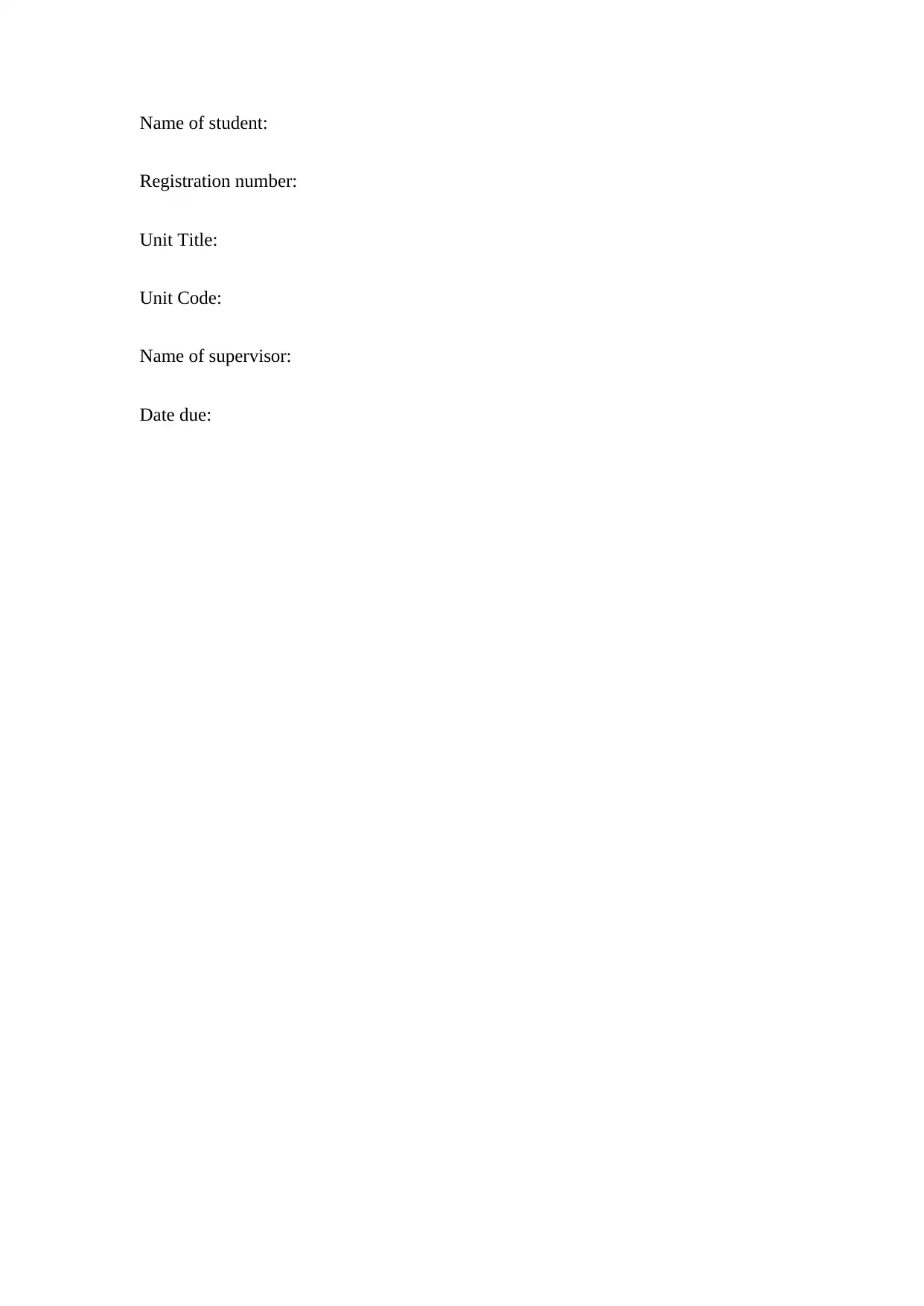
Name of student:
Registration number:
Unit Title:
Unit Code:
Name of supervisor:
Date due:
Registration number:
Unit Title:
Unit Code:
Name of supervisor:
Date due:
Paraphrase This Document
Need a fresh take? Get an instant paraphrase of this document with our AI Paraphraser

Introduction
This report evaluates the safety and health regulation in the aircraft and airport
hangers. There are many safety and health regulations and legislation that govern
airplanes in airports. Airplane maintenance is an occupation that involves various
risks and it is very important that employees and everyone involved in activities at the
hanger are aware and strictly follow the legislation and regulations (Tompa, Culyer &
Dolinschi, 2008). Aircraft and avionics equipment mechanics experiences high rates
of illness and injuries that are higher than the national average of injuries in the UK
Aircraft maintenance. This report discusses health and safety issues and regulations in
aircraft maintenance. The report discusses different categories and classes of aircraft
safety to help understand the risk factors involved and the safety measures for all
employees of “Just A Trip”. All the risk factors that employees working in the aircraft
hanger are exposed to are discussed in the report.
Control of Substances Hazardous to Health
The control of substances hazardous to health regulation 1999 states that some
substances which are classified as hazardous to health and which employees are
exposed to must be identified and the health risks they pose to employees must be
assessed. Substances that can be classified as hazardous include gases, vapors, liquids,
chemicals, fumes, and dust.
The Chemicals Regulations 1994 classifies a substance as hazardous if:
A substance must be toxic, harmful, corrosive, sensitizing or irritant
It has maximum exposure limits
Has occupational exposure standards
This report evaluates the safety and health regulation in the aircraft and airport
hangers. There are many safety and health regulations and legislation that govern
airplanes in airports. Airplane maintenance is an occupation that involves various
risks and it is very important that employees and everyone involved in activities at the
hanger are aware and strictly follow the legislation and regulations (Tompa, Culyer &
Dolinschi, 2008). Aircraft and avionics equipment mechanics experiences high rates
of illness and injuries that are higher than the national average of injuries in the UK
Aircraft maintenance. This report discusses health and safety issues and regulations in
aircraft maintenance. The report discusses different categories and classes of aircraft
safety to help understand the risk factors involved and the safety measures for all
employees of “Just A Trip”. All the risk factors that employees working in the aircraft
hanger are exposed to are discussed in the report.
Control of Substances Hazardous to Health
The control of substances hazardous to health regulation 1999 states that some
substances which are classified as hazardous to health and which employees are
exposed to must be identified and the health risks they pose to employees must be
assessed. Substances that can be classified as hazardous include gases, vapors, liquids,
chemicals, fumes, and dust.
The Chemicals Regulations 1994 classifies a substance as hazardous if:
A substance must be toxic, harmful, corrosive, sensitizing or irritant
It has maximum exposure limits
Has occupational exposure standards
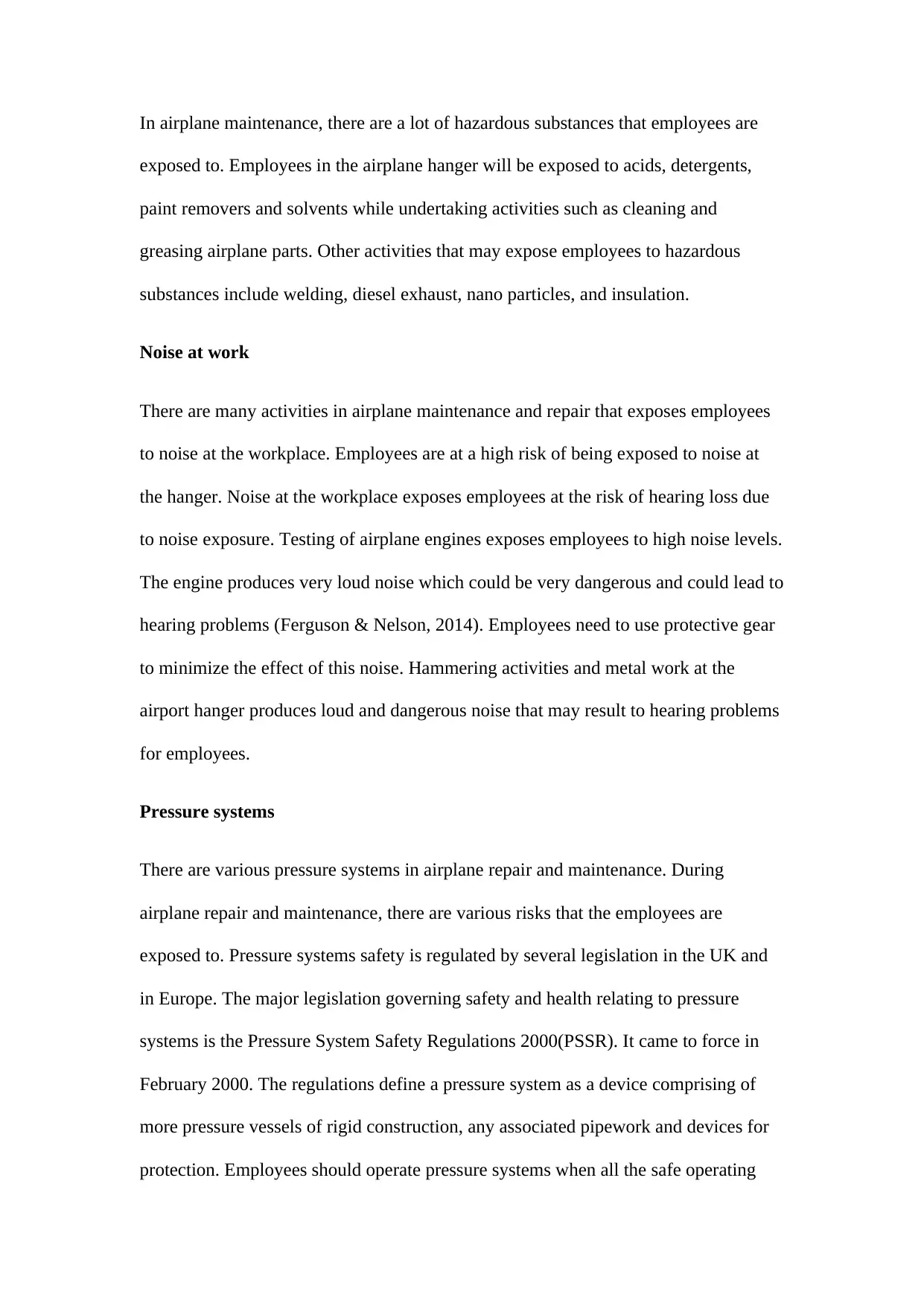
In airplane maintenance, there are a lot of hazardous substances that employees are
exposed to. Employees in the airplane hanger will be exposed to acids, detergents,
paint removers and solvents while undertaking activities such as cleaning and
greasing airplane parts. Other activities that may expose employees to hazardous
substances include welding, diesel exhaust, nano particles, and insulation.
Noise at work
There are many activities in airplane maintenance and repair that exposes employees
to noise at the workplace. Employees are at a high risk of being exposed to noise at
the hanger. Noise at the workplace exposes employees at the risk of hearing loss due
to noise exposure. Testing of airplane engines exposes employees to high noise levels.
The engine produces very loud noise which could be very dangerous and could lead to
hearing problems (Ferguson & Nelson, 2014). Employees need to use protective gear
to minimize the effect of this noise. Hammering activities and metal work at the
airport hanger produces loud and dangerous noise that may result to hearing problems
for employees.
Pressure systems
There are various pressure systems in airplane repair and maintenance. During
airplane repair and maintenance, there are various risks that the employees are
exposed to. Pressure systems safety is regulated by several legislation in the UK and
in Europe. The major legislation governing safety and health relating to pressure
systems is the Pressure System Safety Regulations 2000(PSSR). It came to force in
February 2000. The regulations define a pressure system as a device comprising of
more pressure vessels of rigid construction, any associated pipework and devices for
protection. Employees should operate pressure systems when all the safe operating
exposed to. Employees in the airplane hanger will be exposed to acids, detergents,
paint removers and solvents while undertaking activities such as cleaning and
greasing airplane parts. Other activities that may expose employees to hazardous
substances include welding, diesel exhaust, nano particles, and insulation.
Noise at work
There are many activities in airplane maintenance and repair that exposes employees
to noise at the workplace. Employees are at a high risk of being exposed to noise at
the hanger. Noise at the workplace exposes employees at the risk of hearing loss due
to noise exposure. Testing of airplane engines exposes employees to high noise levels.
The engine produces very loud noise which could be very dangerous and could lead to
hearing problems (Ferguson & Nelson, 2014). Employees need to use protective gear
to minimize the effect of this noise. Hammering activities and metal work at the
airport hanger produces loud and dangerous noise that may result to hearing problems
for employees.
Pressure systems
There are various pressure systems in airplane repair and maintenance. During
airplane repair and maintenance, there are various risks that the employees are
exposed to. Pressure systems safety is regulated by several legislation in the UK and
in Europe. The major legislation governing safety and health relating to pressure
systems is the Pressure System Safety Regulations 2000(PSSR). It came to force in
February 2000. The regulations define a pressure system as a device comprising of
more pressure vessels of rigid construction, any associated pipework and devices for
protection. Employees should operate pressure systems when all the safe operating
⊘ This is a preview!⊘
Do you want full access?
Subscribe today to unlock all pages.

Trusted by 1+ million students worldwide
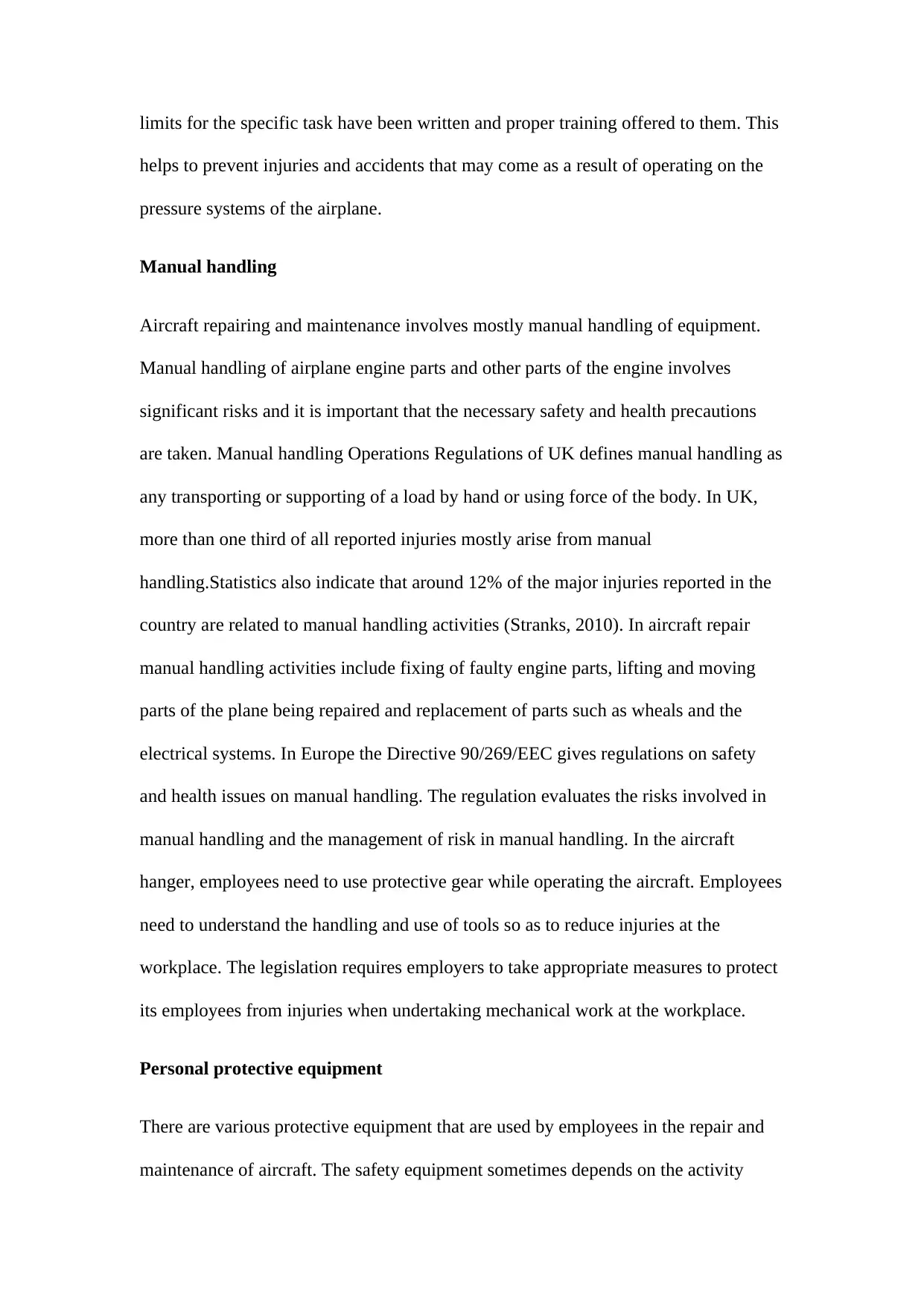
limits for the specific task have been written and proper training offered to them. This
helps to prevent injuries and accidents that may come as a result of operating on the
pressure systems of the airplane.
Manual handling
Aircraft repairing and maintenance involves mostly manual handling of equipment.
Manual handling of airplane engine parts and other parts of the engine involves
significant risks and it is important that the necessary safety and health precautions
are taken. Manual handling Operations Regulations of UK defines manual handling as
any transporting or supporting of a load by hand or using force of the body. In UK,
more than one third of all reported injuries mostly arise from manual
handling.Statistics also indicate that around 12% of the major injuries reported in the
country are related to manual handling activities (Stranks, 2010). In aircraft repair
manual handling activities include fixing of faulty engine parts, lifting and moving
parts of the plane being repaired and replacement of parts such as wheals and the
electrical systems. In Europe the Directive 90/269/EEC gives regulations on safety
and health issues on manual handling. The regulation evaluates the risks involved in
manual handling and the management of risk in manual handling. In the aircraft
hanger, employees need to use protective gear while operating the aircraft. Employees
need to understand the handling and use of tools so as to reduce injuries at the
workplace. The legislation requires employers to take appropriate measures to protect
its employees from injuries when undertaking mechanical work at the workplace.
Personal protective equipment
There are various protective equipment that are used by employees in the repair and
maintenance of aircraft. The safety equipment sometimes depends on the activity
helps to prevent injuries and accidents that may come as a result of operating on the
pressure systems of the airplane.
Manual handling
Aircraft repairing and maintenance involves mostly manual handling of equipment.
Manual handling of airplane engine parts and other parts of the engine involves
significant risks and it is important that the necessary safety and health precautions
are taken. Manual handling Operations Regulations of UK defines manual handling as
any transporting or supporting of a load by hand or using force of the body. In UK,
more than one third of all reported injuries mostly arise from manual
handling.Statistics also indicate that around 12% of the major injuries reported in the
country are related to manual handling activities (Stranks, 2010). In aircraft repair
manual handling activities include fixing of faulty engine parts, lifting and moving
parts of the plane being repaired and replacement of parts such as wheals and the
electrical systems. In Europe the Directive 90/269/EEC gives regulations on safety
and health issues on manual handling. The regulation evaluates the risks involved in
manual handling and the management of risk in manual handling. In the aircraft
hanger, employees need to use protective gear while operating the aircraft. Employees
need to understand the handling and use of tools so as to reduce injuries at the
workplace. The legislation requires employers to take appropriate measures to protect
its employees from injuries when undertaking mechanical work at the workplace.
Personal protective equipment
There are various protective equipment that are used by employees in the repair and
maintenance of aircraft. The safety equipment sometimes depends on the activity
Paraphrase This Document
Need a fresh take? Get an instant paraphrase of this document with our AI Paraphraser
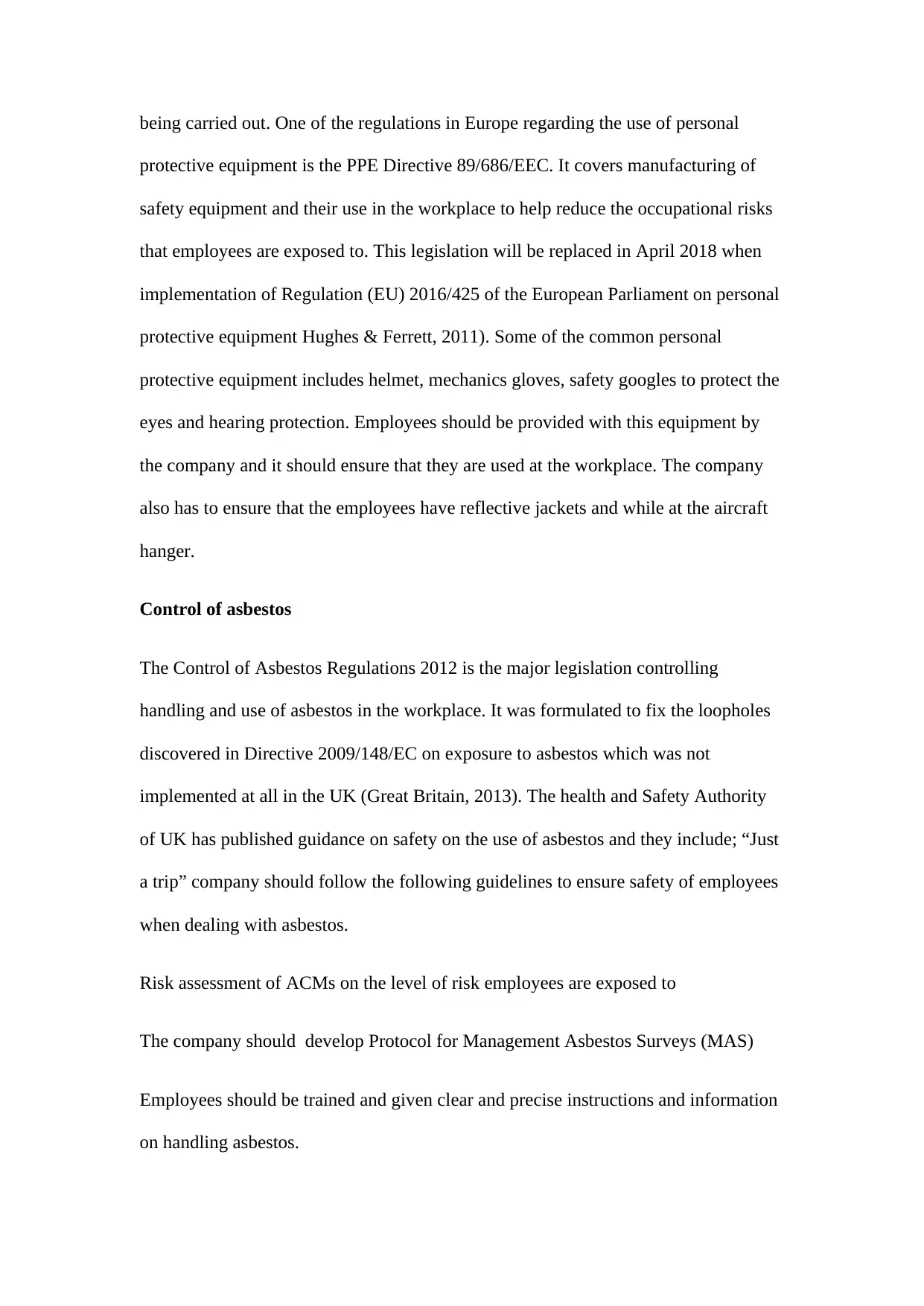
being carried out. One of the regulations in Europe regarding the use of personal
protective equipment is the PPE Directive 89/686/EEC. It covers manufacturing of
safety equipment and their use in the workplace to help reduce the occupational risks
that employees are exposed to. This legislation will be replaced in April 2018 when
implementation of Regulation (EU) 2016/425 of the European Parliament on personal
protective equipment Hughes & Ferrett, 2011). Some of the common personal
protective equipment includes helmet, mechanics gloves, safety googles to protect the
eyes and hearing protection. Employees should be provided with this equipment by
the company and it should ensure that they are used at the workplace. The company
also has to ensure that the employees have reflective jackets and while at the aircraft
hanger.
Control of asbestos
The Control of Asbestos Regulations 2012 is the major legislation controlling
handling and use of asbestos in the workplace. It was formulated to fix the loopholes
discovered in Directive 2009/148/EC on exposure to asbestos which was not
implemented at all in the UK (Great Britain, 2013). The health and Safety Authority
of UK has published guidance on safety on the use of asbestos and they include; “Just
a trip” company should follow the following guidelines to ensure safety of employees
when dealing with asbestos.
Risk assessment of ACMs on the level of risk employees are exposed to
The company should develop Protocol for Management Asbestos Surveys (MAS)
Employees should be trained and given clear and precise instructions and information
on handling asbestos.
protective equipment is the PPE Directive 89/686/EEC. It covers manufacturing of
safety equipment and their use in the workplace to help reduce the occupational risks
that employees are exposed to. This legislation will be replaced in April 2018 when
implementation of Regulation (EU) 2016/425 of the European Parliament on personal
protective equipment Hughes & Ferrett, 2011). Some of the common personal
protective equipment includes helmet, mechanics gloves, safety googles to protect the
eyes and hearing protection. Employees should be provided with this equipment by
the company and it should ensure that they are used at the workplace. The company
also has to ensure that the employees have reflective jackets and while at the aircraft
hanger.
Control of asbestos
The Control of Asbestos Regulations 2012 is the major legislation controlling
handling and use of asbestos in the workplace. It was formulated to fix the loopholes
discovered in Directive 2009/148/EC on exposure to asbestos which was not
implemented at all in the UK (Great Britain, 2013). The health and Safety Authority
of UK has published guidance on safety on the use of asbestos and they include; “Just
a trip” company should follow the following guidelines to ensure safety of employees
when dealing with asbestos.
Risk assessment of ACMs on the level of risk employees are exposed to
The company should develop Protocol for Management Asbestos Surveys (MAS)
Employees should be trained and given clear and precise instructions and information
on handling asbestos.

The company should buy personal protective equipment for working with asbestos
The management should develop an Health Surveillance and exposure registers
Health and safety at work Act
The health and safety Act contains many regulations on health and safety at the
workplace which apply to all employers. The regulations are as follows;
The health and Safety Executive (HSE)
Health and Safety at Work Act 1974
Management of Health and Safety at Work Regulations 1999
Reporting of injuries, diseases and dangerous occurrence regulations 1995
Workplace (Health, Safety and Welfare) Regulations 1992
The Health and Safety Executive (HSE) is responsible for enforcing health and safety
at work regulations at the workplace and it ensures that all the regulations are adhered
to by all organizations.
Management of health and safety at work
Management of health and safety at work involves a wide range of actions and
regulations to help protect employees. It is important for all organizations to assess
the level of risk the employees are exposed to at the workplace. The organization can
then be able to put measures in place to manage these risks and ensure that all
employees at the workplace are safe and healthy Great Britain. 2013).”Just a trip”
should also train its employees on handling of tools at the workplace. Safety rules and
procedures should be written and placed at strategic points within the hanger to ensure
The management should develop an Health Surveillance and exposure registers
Health and safety at work Act
The health and safety Act contains many regulations on health and safety at the
workplace which apply to all employers. The regulations are as follows;
The health and Safety Executive (HSE)
Health and Safety at Work Act 1974
Management of Health and Safety at Work Regulations 1999
Reporting of injuries, diseases and dangerous occurrence regulations 1995
Workplace (Health, Safety and Welfare) Regulations 1992
The Health and Safety Executive (HSE) is responsible for enforcing health and safety
at work regulations at the workplace and it ensures that all the regulations are adhered
to by all organizations.
Management of health and safety at work
Management of health and safety at work involves a wide range of actions and
regulations to help protect employees. It is important for all organizations to assess
the level of risk the employees are exposed to at the workplace. The organization can
then be able to put measures in place to manage these risks and ensure that all
employees at the workplace are safe and healthy Great Britain. 2013).”Just a trip”
should also train its employees on handling of tools at the workplace. Safety rules and
procedures should be written and placed at strategic points within the hanger to ensure
⊘ This is a preview!⊘
Do you want full access?
Subscribe today to unlock all pages.

Trusted by 1+ million students worldwide
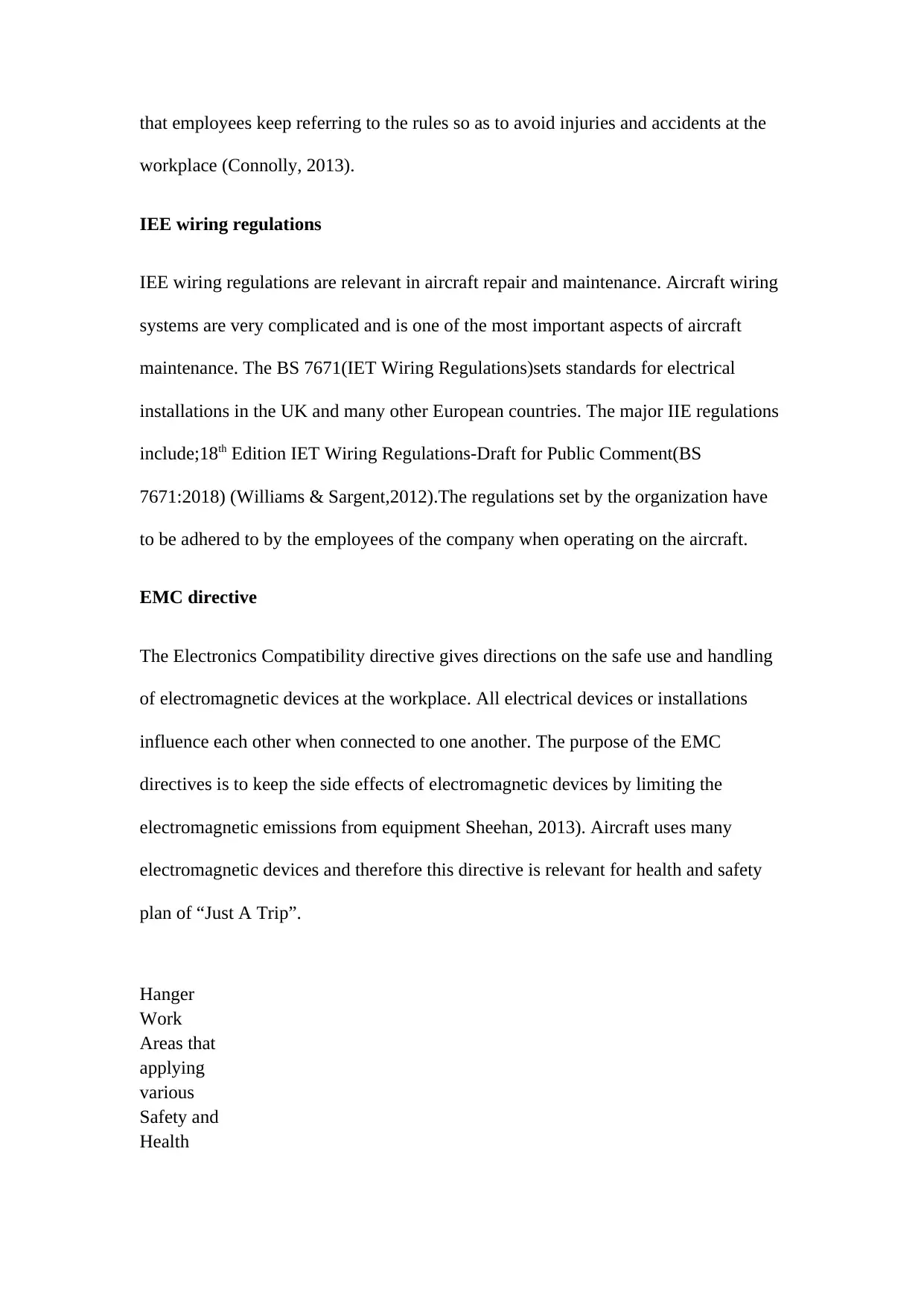
that employees keep referring to the rules so as to avoid injuries and accidents at the
workplace (Connolly, 2013).
IEE wiring regulations
IEE wiring regulations are relevant in aircraft repair and maintenance. Aircraft wiring
systems are very complicated and is one of the most important aspects of aircraft
maintenance. The BS 7671(IET Wiring Regulations)sets standards for electrical
installations in the UK and many other European countries. The major IIE regulations
include;18th Edition IET Wiring Regulations-Draft for Public Comment(BS
7671:2018) (Williams & Sargent,2012).The regulations set by the organization have
to be adhered to by the employees of the company when operating on the aircraft.
EMC directive
The Electronics Compatibility directive gives directions on the safe use and handling
of electromagnetic devices at the workplace. All electrical devices or installations
influence each other when connected to one another. The purpose of the EMC
directives is to keep the side effects of electromagnetic devices by limiting the
electromagnetic emissions from equipment Sheehan, 2013). Aircraft uses many
electromagnetic devices and therefore this directive is relevant for health and safety
plan of “Just A Trip”.
Hanger
Work
Areas that
applying
various
Safety and
Health
workplace (Connolly, 2013).
IEE wiring regulations
IEE wiring regulations are relevant in aircraft repair and maintenance. Aircraft wiring
systems are very complicated and is one of the most important aspects of aircraft
maintenance. The BS 7671(IET Wiring Regulations)sets standards for electrical
installations in the UK and many other European countries. The major IIE regulations
include;18th Edition IET Wiring Regulations-Draft for Public Comment(BS
7671:2018) (Williams & Sargent,2012).The regulations set by the organization have
to be adhered to by the employees of the company when operating on the aircraft.
EMC directive
The Electronics Compatibility directive gives directions on the safe use and handling
of electromagnetic devices at the workplace. All electrical devices or installations
influence each other when connected to one another. The purpose of the EMC
directives is to keep the side effects of electromagnetic devices by limiting the
electromagnetic emissions from equipment Sheehan, 2013). Aircraft uses many
electromagnetic devices and therefore this directive is relevant for health and safety
plan of “Just A Trip”.
Hanger
Work
Areas that
applying
various
Safety and
Health
Paraphrase This Document
Need a fresh take? Get an instant paraphrase of this document with our AI Paraphraser
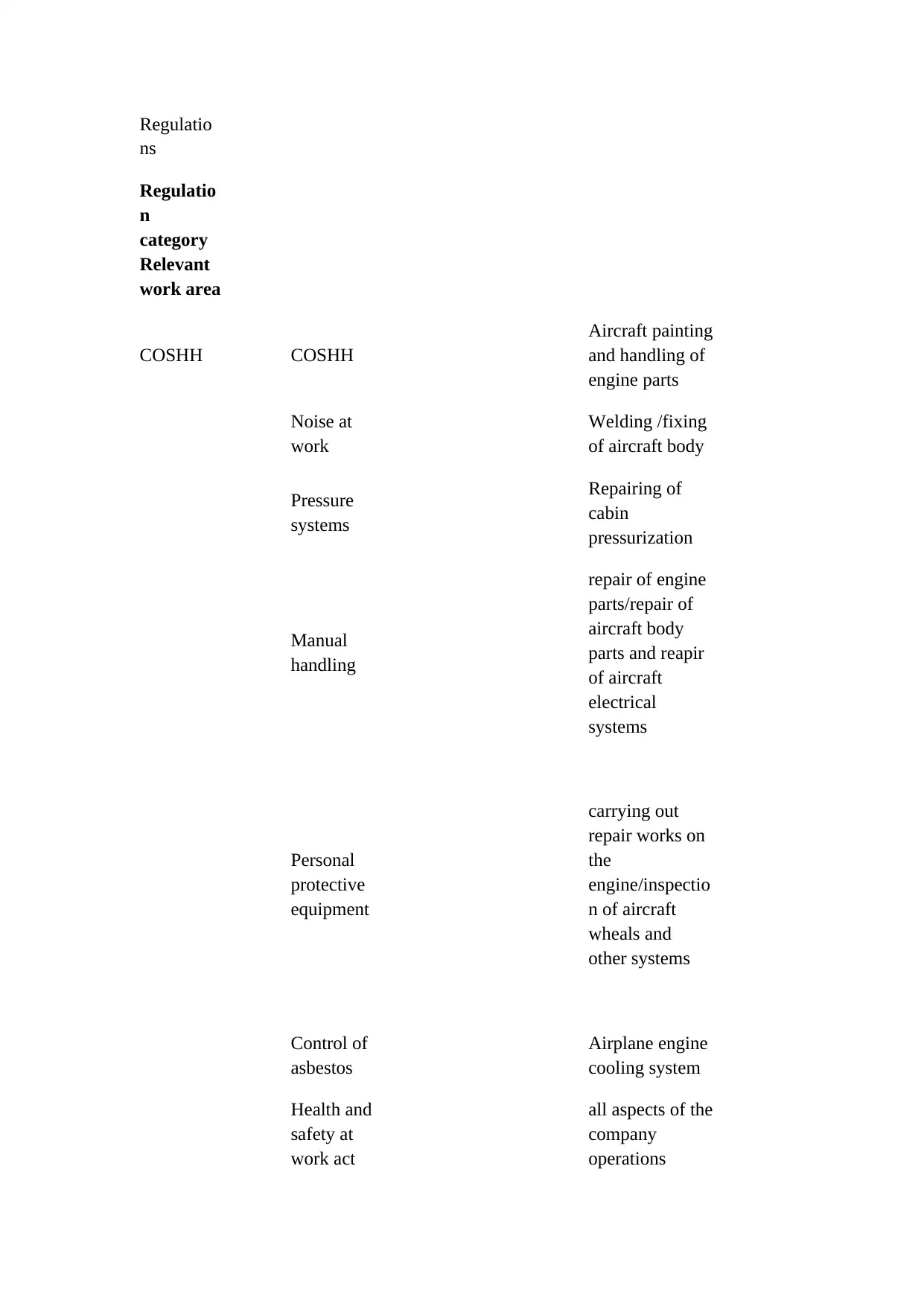
Regulatio
ns
Regulatio
n
category
Relevant
work area
COSHH COSHH
Aircraft painting
and handling of
engine parts
Noise at
work
Welding /fixing
of aircraft body
Pressure
systems
Repairing of
cabin
pressurization
Manual
handling
repair of engine
parts/repair of
aircraft body
parts and reapir
of aircraft
electrical
systems
Personal
protective
equipment
carrying out
repair works on
the
engine/inspectio
n of aircraft
wheals and
other systems
Control of
asbestos
Airplane engine
cooling system
Health and
safety at
work act
all aspects of the
company
operations
ns
Regulatio
n
category
Relevant
work area
COSHH COSHH
Aircraft painting
and handling of
engine parts
Noise at
work
Welding /fixing
of aircraft body
Pressure
systems
Repairing of
cabin
pressurization
Manual
handling
repair of engine
parts/repair of
aircraft body
parts and reapir
of aircraft
electrical
systems
Personal
protective
equipment
carrying out
repair works on
the
engine/inspectio
n of aircraft
wheals and
other systems
Control of
asbestos
Airplane engine
cooling system
Health and
safety at
work act
all aspects of the
company
operations
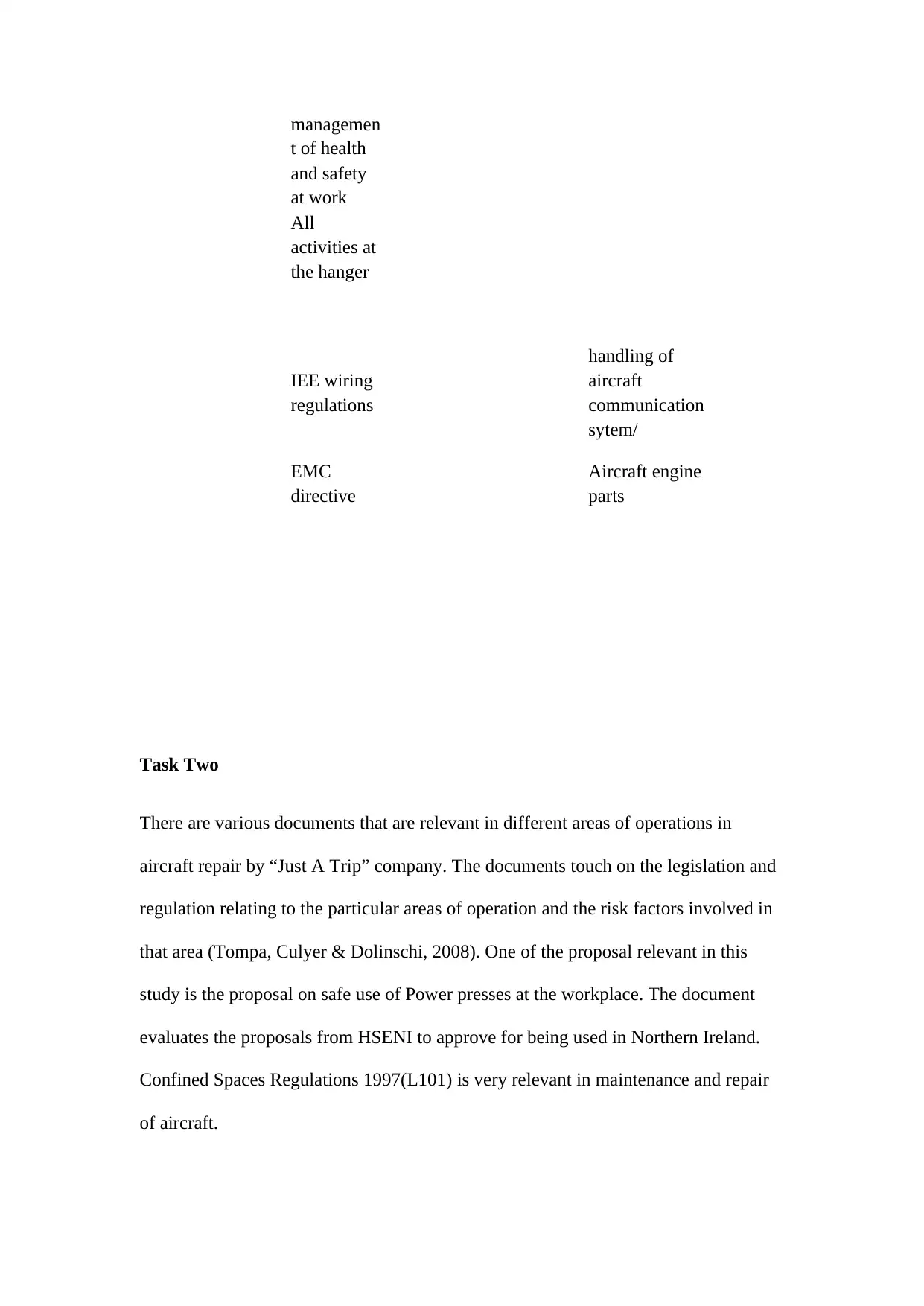
managemen
t of health
and safety
at work
All
activities at
the hanger
IEE wiring
regulations
handling of
aircraft
communication
sytem/
EMC
directive
Aircraft engine
parts
Task Two
There are various documents that are relevant in different areas of operations in
aircraft repair by “Just A Trip” company. The documents touch on the legislation and
regulation relating to the particular areas of operation and the risk factors involved in
that area (Tompa, Culyer & Dolinschi, 2008). One of the proposal relevant in this
study is the proposal on safe use of Power presses at the workplace. The document
evaluates the proposals from HSENI to approve for being used in Northern Ireland.
Confined Spaces Regulations 1997(L101) is very relevant in maintenance and repair
of aircraft.
t of health
and safety
at work
All
activities at
the hanger
IEE wiring
regulations
handling of
aircraft
communication
sytem/
EMC
directive
Aircraft engine
parts
Task Two
There are various documents that are relevant in different areas of operations in
aircraft repair by “Just A Trip” company. The documents touch on the legislation and
regulation relating to the particular areas of operation and the risk factors involved in
that area (Tompa, Culyer & Dolinschi, 2008). One of the proposal relevant in this
study is the proposal on safe use of Power presses at the workplace. The document
evaluates the proposals from HSENI to approve for being used in Northern Ireland.
Confined Spaces Regulations 1997(L101) is very relevant in maintenance and repair
of aircraft.
⊘ This is a preview!⊘
Do you want full access?
Subscribe today to unlock all pages.

Trusted by 1+ million students worldwide
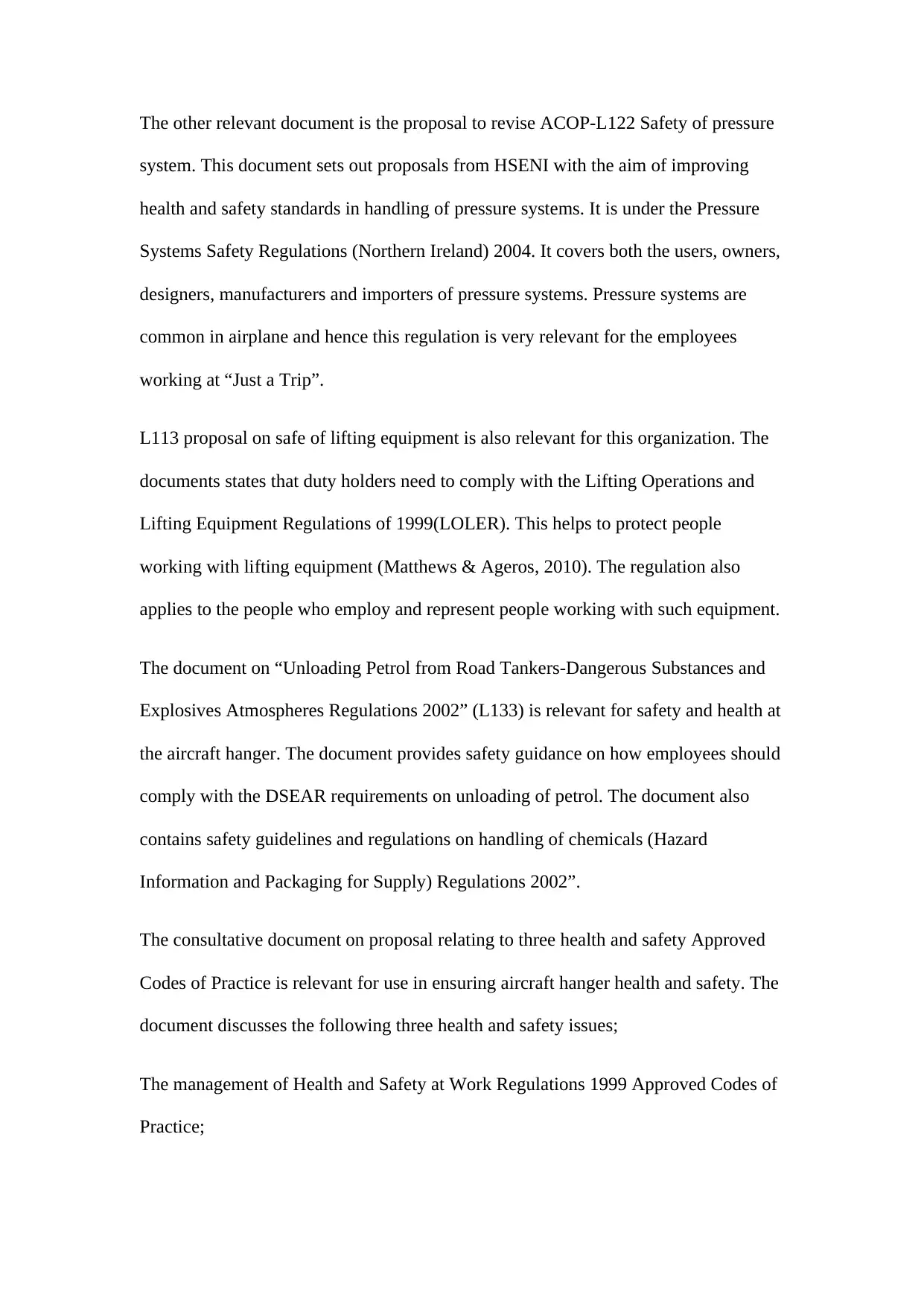
The other relevant document is the proposal to revise ACOP-L122 Safety of pressure
system. This document sets out proposals from HSENI with the aim of improving
health and safety standards in handling of pressure systems. It is under the Pressure
Systems Safety Regulations (Northern Ireland) 2004. It covers both the users, owners,
designers, manufacturers and importers of pressure systems. Pressure systems are
common in airplane and hence this regulation is very relevant for the employees
working at “Just a Trip”.
L113 proposal on safe of lifting equipment is also relevant for this organization. The
documents states that duty holders need to comply with the Lifting Operations and
Lifting Equipment Regulations of 1999(LOLER). This helps to protect people
working with lifting equipment (Matthews & Ageros, 2010). The regulation also
applies to the people who employ and represent people working with such equipment.
The document on “Unloading Petrol from Road Tankers-Dangerous Substances and
Explosives Atmospheres Regulations 2002” (L133) is relevant for safety and health at
the aircraft hanger. The document provides safety guidance on how employees should
comply with the DSEAR requirements on unloading of petrol. The document also
contains safety guidelines and regulations on handling of chemicals (Hazard
Information and Packaging for Supply) Regulations 2002”.
The consultative document on proposal relating to three health and safety Approved
Codes of Practice is relevant for use in ensuring aircraft hanger health and safety. The
document discusses the following three health and safety issues;
The management of Health and Safety at Work Regulations 1999 Approved Codes of
Practice;
system. This document sets out proposals from HSENI with the aim of improving
health and safety standards in handling of pressure systems. It is under the Pressure
Systems Safety Regulations (Northern Ireland) 2004. It covers both the users, owners,
designers, manufacturers and importers of pressure systems. Pressure systems are
common in airplane and hence this regulation is very relevant for the employees
working at “Just a Trip”.
L113 proposal on safe of lifting equipment is also relevant for this organization. The
documents states that duty holders need to comply with the Lifting Operations and
Lifting Equipment Regulations of 1999(LOLER). This helps to protect people
working with lifting equipment (Matthews & Ageros, 2010). The regulation also
applies to the people who employ and represent people working with such equipment.
The document on “Unloading Petrol from Road Tankers-Dangerous Substances and
Explosives Atmospheres Regulations 2002” (L133) is relevant for safety and health at
the aircraft hanger. The document provides safety guidance on how employees should
comply with the DSEAR requirements on unloading of petrol. The document also
contains safety guidelines and regulations on handling of chemicals (Hazard
Information and Packaging for Supply) Regulations 2002”.
The consultative document on proposal relating to three health and safety Approved
Codes of Practice is relevant for use in ensuring aircraft hanger health and safety. The
document discusses the following three health and safety issues;
The management of Health and Safety at Work Regulations 1999 Approved Codes of
Practice;
Paraphrase This Document
Need a fresh take? Get an instant paraphrase of this document with our AI Paraphraser
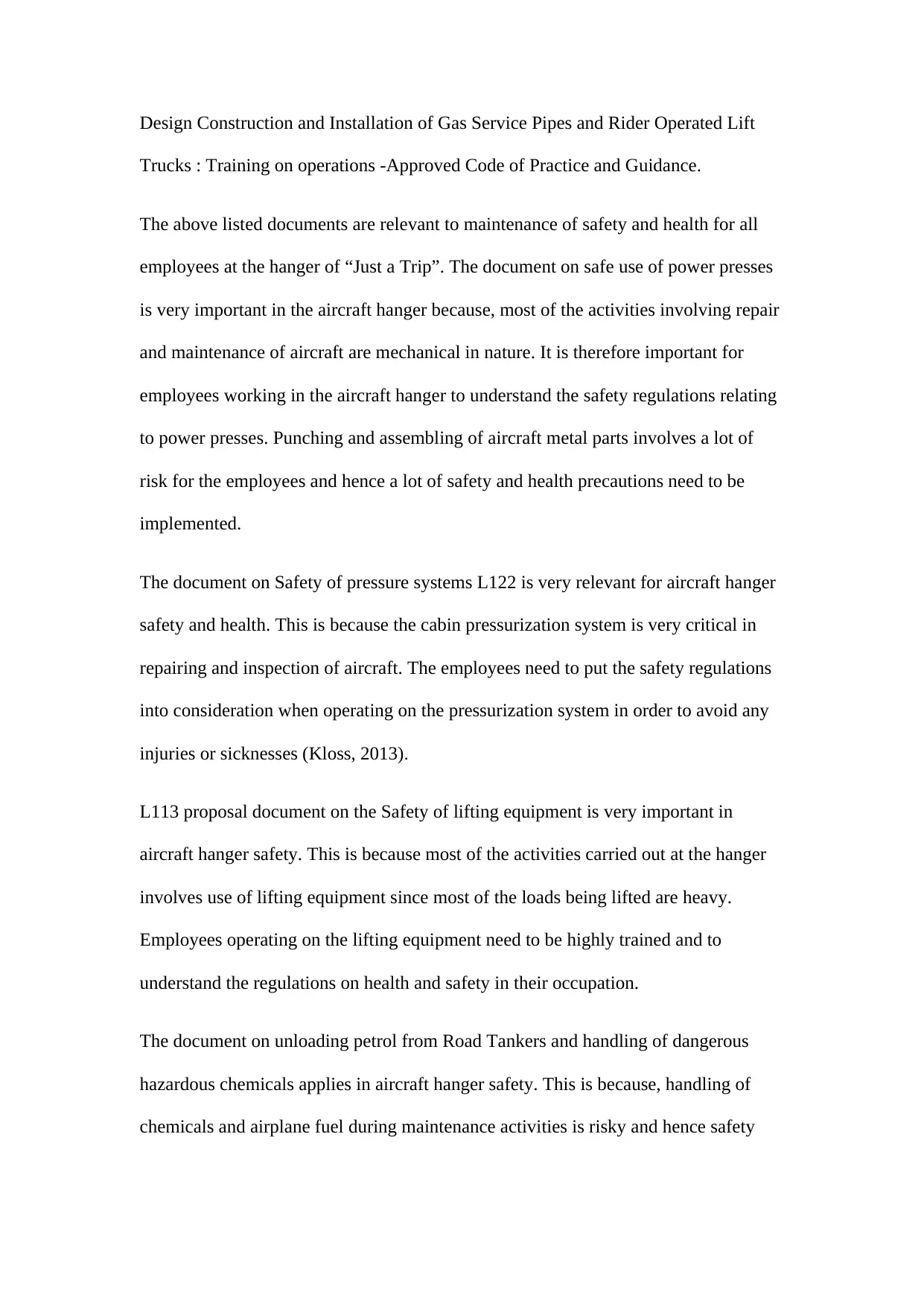
Design Construction and Installation of Gas Service Pipes and Rider Operated Lift
Trucks : Training on operations -Approved Code of Practice and Guidance.
The above listed documents are relevant to maintenance of safety and health for all
employees at the hanger of “Just a Trip”. The document on safe use of power presses
is very important in the aircraft hanger because, most of the activities involving repair
and maintenance of aircraft are mechanical in nature. It is therefore important for
employees working in the aircraft hanger to understand the safety regulations relating
to power presses. Punching and assembling of aircraft metal parts involves a lot of
risk for the employees and hence a lot of safety and health precautions need to be
implemented.
The document on Safety of pressure systems L122 is very relevant for aircraft hanger
safety and health. This is because the cabin pressurization system is very critical in
repairing and inspection of aircraft. The employees need to put the safety regulations
into consideration when operating on the pressurization system in order to avoid any
injuries or sicknesses (Kloss, 2013).
L113 proposal document on the Safety of lifting equipment is very important in
aircraft hanger safety. This is because most of the activities carried out at the hanger
involves use of lifting equipment since most of the loads being lifted are heavy.
Employees operating on the lifting equipment need to be highly trained and to
understand the regulations on health and safety in their occupation.
The document on unloading petrol from Road Tankers and handling of dangerous
hazardous chemicals applies in aircraft hanger safety. This is because, handling of
chemicals and airplane fuel during maintenance activities is risky and hence safety
Trucks : Training on operations -Approved Code of Practice and Guidance.
The above listed documents are relevant to maintenance of safety and health for all
employees at the hanger of “Just a Trip”. The document on safe use of power presses
is very important in the aircraft hanger because, most of the activities involving repair
and maintenance of aircraft are mechanical in nature. It is therefore important for
employees working in the aircraft hanger to understand the safety regulations relating
to power presses. Punching and assembling of aircraft metal parts involves a lot of
risk for the employees and hence a lot of safety and health precautions need to be
implemented.
The document on Safety of pressure systems L122 is very relevant for aircraft hanger
safety and health. This is because the cabin pressurization system is very critical in
repairing and inspection of aircraft. The employees need to put the safety regulations
into consideration when operating on the pressurization system in order to avoid any
injuries or sicknesses (Kloss, 2013).
L113 proposal document on the Safety of lifting equipment is very important in
aircraft hanger safety. This is because most of the activities carried out at the hanger
involves use of lifting equipment since most of the loads being lifted are heavy.
Employees operating on the lifting equipment need to be highly trained and to
understand the regulations on health and safety in their occupation.
The document on unloading petrol from Road Tankers and handling of dangerous
hazardous chemicals applies in aircraft hanger safety. This is because, handling of
chemicals and airplane fuel during maintenance activities is risky and hence safety
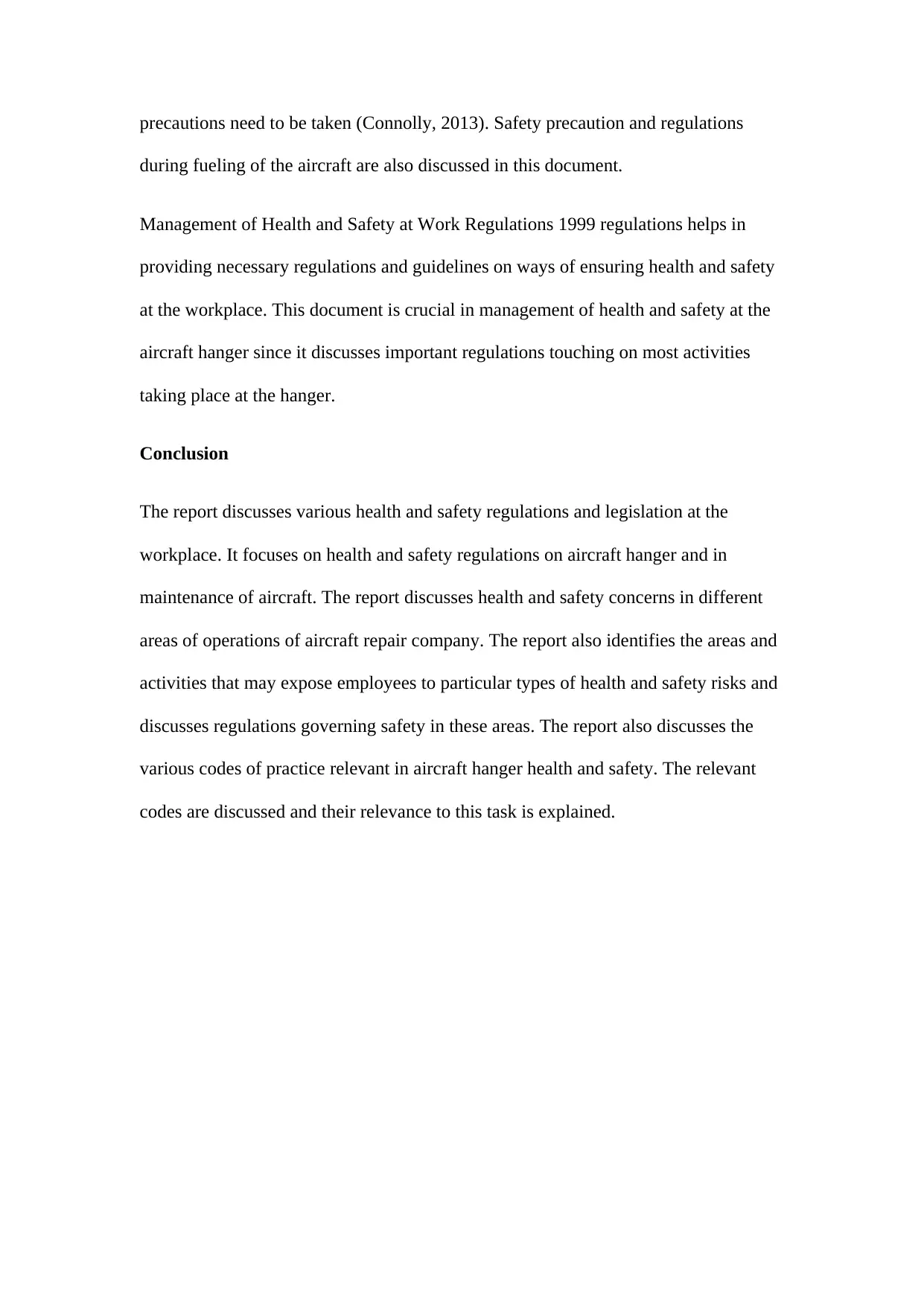
precautions need to be taken (Connolly, 2013). Safety precaution and regulations
during fueling of the aircraft are also discussed in this document.
Management of Health and Safety at Work Regulations 1999 regulations helps in
providing necessary regulations and guidelines on ways of ensuring health and safety
at the workplace. This document is crucial in management of health and safety at the
aircraft hanger since it discusses important regulations touching on most activities
taking place at the hanger.
Conclusion
The report discusses various health and safety regulations and legislation at the
workplace. It focuses on health and safety regulations on aircraft hanger and in
maintenance of aircraft. The report discusses health and safety concerns in different
areas of operations of aircraft repair company. The report also identifies the areas and
activities that may expose employees to particular types of health and safety risks and
discusses regulations governing safety in these areas. The report also discusses the
various codes of practice relevant in aircraft hanger health and safety. The relevant
codes are discussed and their relevance to this task is explained.
during fueling of the aircraft are also discussed in this document.
Management of Health and Safety at Work Regulations 1999 regulations helps in
providing necessary regulations and guidelines on ways of ensuring health and safety
at the workplace. This document is crucial in management of health and safety at the
aircraft hanger since it discusses important regulations touching on most activities
taking place at the hanger.
Conclusion
The report discusses various health and safety regulations and legislation at the
workplace. It focuses on health and safety regulations on aircraft hanger and in
maintenance of aircraft. The report discusses health and safety concerns in different
areas of operations of aircraft repair company. The report also identifies the areas and
activities that may expose employees to particular types of health and safety risks and
discusses regulations governing safety in these areas. The report also discusses the
various codes of practice relevant in aircraft hanger health and safety. The relevant
codes are discussed and their relevance to this task is explained.
⊘ This is a preview!⊘
Do you want full access?
Subscribe today to unlock all pages.

Trusted by 1+ million students worldwide
1 out of 14
Related Documents
Your All-in-One AI-Powered Toolkit for Academic Success.
+13062052269
info@desklib.com
Available 24*7 on WhatsApp / Email
![[object Object]](/_next/static/media/star-bottom.7253800d.svg)
Unlock your academic potential
Copyright © 2020–2026 A2Z Services. All Rights Reserved. Developed and managed by ZUCOL.





